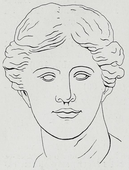Facial symmetry is one specific measure of bodily symmetry. Along with traits such as averageness and youthfulness, it influences judgments of aesthetic traits of physical attractiveness and beauty.[1] For instance, in mate selection, people have been shown to have a preference for symmetry.[2][3]
Facial bilateral symmetry is typically defined as fluctuating asymmetry of the face comparing random differences in facial features of the two sides of the face.[4] The human face also has systematic, directional asymmetry: on average, the face (mouth, nose and eyes) sits systematically to the left with respect to the axis through the ears, the so-called aurofacial asymmetry.[5]
- ^ Grammer, K.; Thornhill, R. (October 1994). "Human (Homo sapiens) facial attractiveness and sexual selection: the role of symmetry and averageness". Journal of Comparative Psychology. 108 (3): 233–42. doi:10.1037/0735-7036.108.3.233. PMID 7924253. S2CID 1205083. Retrieved 4 May 2019.
- ^ Rhodes, Gillian; Zebrowitz, Leslie A. (2002). Facial Attractiveness: Evolutionary, Cognitive, and Social Perspectives. Ablex. ISBN 978-1-56750-636-5.
- ^ Jones, B. C.; Little, A. C.; Penton-Voak, I. S.; Tiddeman, B. P.; Burt, D. M.; Perrett, D. I. (November 2001). "Facial symmetry and judgements of apparent health". Evolution and Human Behavior. 22 (6): 417–429. doi:10.1016/S1090-5138(01)00083-6.
- ^ Penton-Voak, I. S.; Jones, B. C.; Little; Baker, S.; Tiddeman, B.; Burt, D. M.; Perrett, D. I. (2001). "Symmetry, sexual dimorphism in facial proportions and male facial attractiveness". Proceedings: Biological Sciences. 268 (1476): 1617–1623. doi:10.1098/rspb.2001.1703. PMC 1088785. PMID 11487409.
- ^ de Lussanet, M. H. E. (2019). "Opposite asymmetries of face and trunk and of kissing and hugging, as predicted by the axial twist hypothesis". PeerJ. 7: e7096. doi:10.7717/peerj.7096. PMC 6557252. PMID 31211022.


